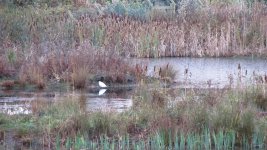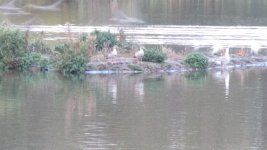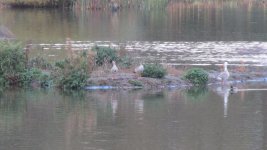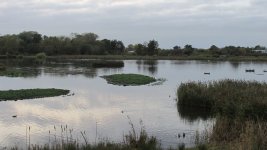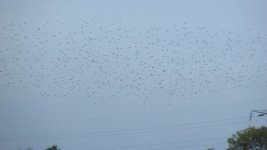Bearded Tit Panurus biarmicus
Along with Marsh Harrier and Bittern, Bearded Tit forms part of the Holy Trinity that represent a successful reed-bed. It is therefore a huge stain on the character of Upton Warren that the reserve has not recorded this species for 22 years and represents a significant hole in the list of many regulars (including myself).
Bearded Tit is an uncommon resident in Britain with around 630 pairs (as per the BTO) which breeds in extensive swathes of Common Reed in such locations as Dorset, Kent, East Anglia, Lancashire (eg Leighton Moss) and the east coast (eg Blacktoft Sands) with recent expansion into new areas as the Somerset Levels. Birds reach the West Midlands on an occasional basis, with around 30 records for Worcestershire, the most recent being a female at Grimley Old Workings between the 23rd and 30th October 2004. At Upton Warren it is a scarce and irregular visitor (although formerly more frequent); there have been 12 records totalling at least 34 birds. Unfortunately some of the data relating to the earlier records is a little sketchy:-
3rd March 1968 - 1 bird (Roger Maskew, BT Nicholls)
31st October 1971 - 2 birds (Roger Maskew, MB Passman)
4th November 1972 - 5 birds (Arthur Jacobs)
14th November 1973 to late March 1974 - 5 birds (Arthur Jacobs)
24th October to 23rd November 1974 - 4 birds (MO)
18th January 1975 - 2 birds (Paul Cooper, Mike Smith)
8th & 9th March 1975 - 2 males (Arthur Jacobs, Simon Harrop)
Late October 1977 to early 1978 - 2, possibly 3, birds (Arthur Jacobs, AJH)
7th to 8th November 1987 - 1+ birds (1 male) - Moors Pool / The Flashes (John Belsey, John Hancock)
17th to 23rd November 1987 - 2 birds (1 male & 1 female) - North Moors (Chris Roe)
13th to 14th October 1992 - 3 birds (2 on 14th) - North Moors (Terry Norledge)
7th to 8th November 1993 - 4 birds (3 males & 1 female) - The Flashes (Paul Croft et al)
Its arrival usually coincides with a westwards movement from populations further east, including the Continent, during the late autumn and early winter; the five birds observed in 1972 formed part of a wider passage that saw over 70 birds reported across the West Midlands region. The vast majority of records have involved multiple occurrences, including a flock of five birds from November 1973 to March 1974, a peak count for the reserve along with the aforementioned 1972 occurrence. The 1978 record involved a pair (and potentially a third bird) seen in late October and early November 1977, with a male bird present until March 1978. The predominance of October and November records coincides with the species’ annual irruption from their main breeding grounds and Upton Warren would appear to have sufficient attractive habitat to hold birds for up to four months.
Unfortunately the run of birds experienced through the 1970s and again, to a lesser degree, in the early 1990s has not materialised into an established wintering pattern. The two November 1987 records could easily involve the same pair of birds; upon departing on the 8th the male bird was later relocated at Westwood Pool, accompanied by a female. The last record in 1993 curtailed the activities of a work party at the Flashes as the four birds spent the afternoon and the following morning in a patch of sedge and willowherb on the southern border of the second Flash; these four birds were later seen at Oakley. Arthur Jacobs recalled that one of the early records included a bird ringed in Poland.
Of current interest is a small irruption that has resulted in a number of records in the last fortnight in the wider Midlands region, far more than in recent years. These sightings include:
Napton Reservoir, Warwicks - 5+ birds - 25th to 28th October
Middleton Lakes / Dosthill complex - 2 birds - 26th & 28th October
Willington Gravel Pits, Derbyshire - 3 birds - 25th & 26th October
Netherfield Lagoons, Notts - 1 bird - 18th October
Salford Priors, Warwicks - 1 bird - 18th October
Uttoxeter Pit, Staffs - 5 birds - 17th October
Rutland Water, Leics - up to 3 birds - 4th to 17th October
The North Moors, main Moors Pool and Hen Pool all have potential to hold this attractive species; visitors should keep an ear open for its distinctive contact call:
http://test.xeno-canto.org/species/Panurus-biarmicus
.





